Goldfish
Carassius auratus
Goldfish and common carp can mate and produce offspring
Advertisement
Goldfish Scientific Classification
- Kingdom
- Animalia
- Phylum
- Chordata
- Class
- Actinopterygii
- Order
- Cypriniformes
- Family
- Cyprinidae
- Genus
- Carassius
- Scientific Name
- Carassius auratus
Read our Complete Guide to Classification of Animals.
Goldfish Conservation Status
Goldfish Facts
- Prey
- Insects, small crustaceans
- Group Behavior
- Gregarious
- Fun Fact
- Goldfish and common carp can mate and produce offspring
- Estimated Population Size
- Many millions
- Biggest Threat
- None
- Most Distinctive Feature
- The orange-gold color of domestic fish
- Optimum pH Level
- 6.0 to 8.0
- Habitat
- Cold freshwater rivers, canals, ditches with lots of vegetation
- Predators
- Waterbirds, turtles, larger fish
- Diet
- Omnivore
- Type
- Fish
- Common Name
- Fish
- Number Of Species
- 1
View all of the Goldfish images!
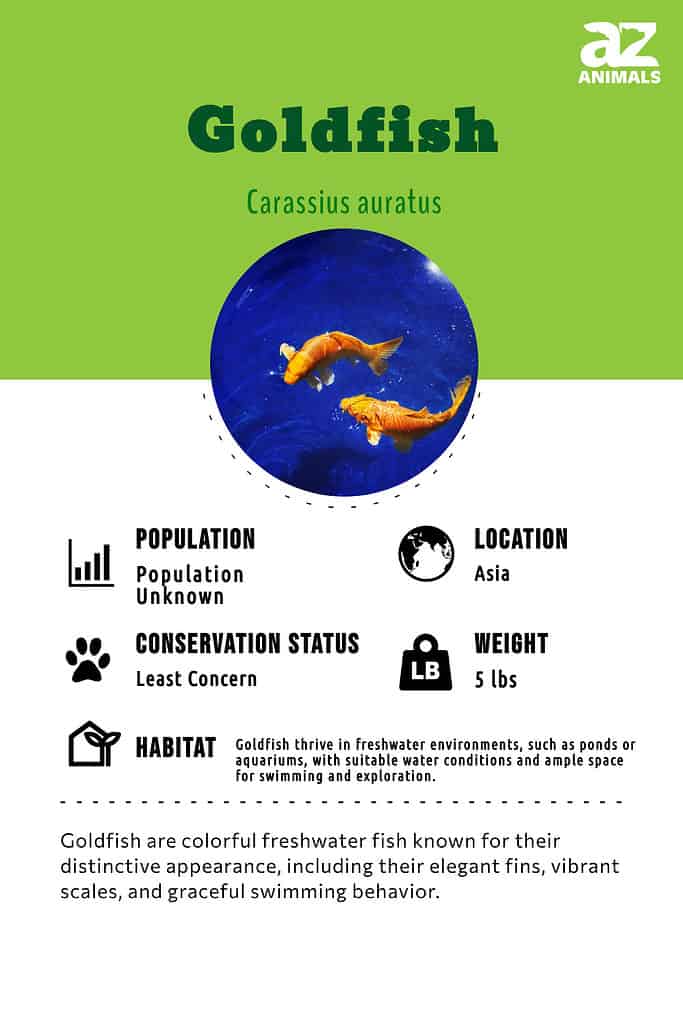
People started breeding Goldfish of different colors in China 1000 years ago. Only members of the imperial Song dynasty were allowed to own them.
Once thought fit only for emperors, the goldfish has become a well-loved pet. Intelligent and curious as well as beautiful, it is hardy and can live a long time.
See all of our expert product reviews.
Read on for more facts about Carassius auratus:
Classification and Scientific Name
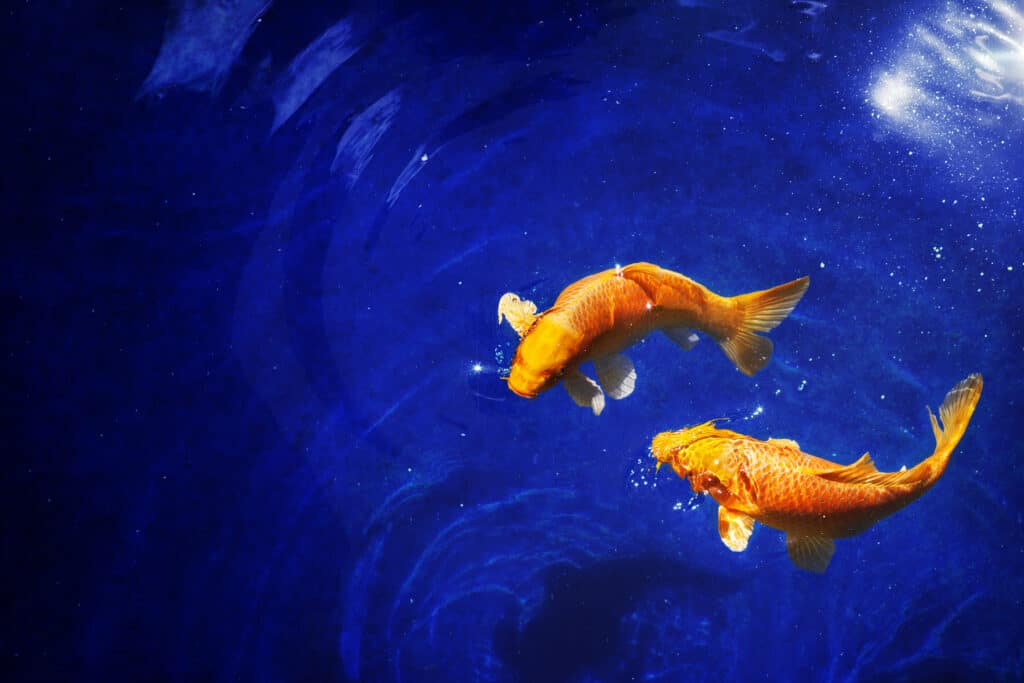
Two golden koi carp fishes close up, dark blue sea background, yellow goldfish swims in water, night moonlight glow, shiny stars, fantastic sky galaxy illustration, Pisces constellation horoscope sign
©iStock.com/Vera Shestak
Goldfish belong to the Cyprinidae family and the Carassius genus, and the scientific name is Carassius auratus. Carassius is derived from the Latin word karass, which is a name for the fish. Auratus means “gilded.”
Biologists used to believe the goldfish was a subspecies of the crucian or Prussian carp, but it is now believed to be its own species.
Health and Entertainment for your Goldfish
See all of our expert product reviews.
Though there are only one species of goldfish there are countless breeds.
Appearance
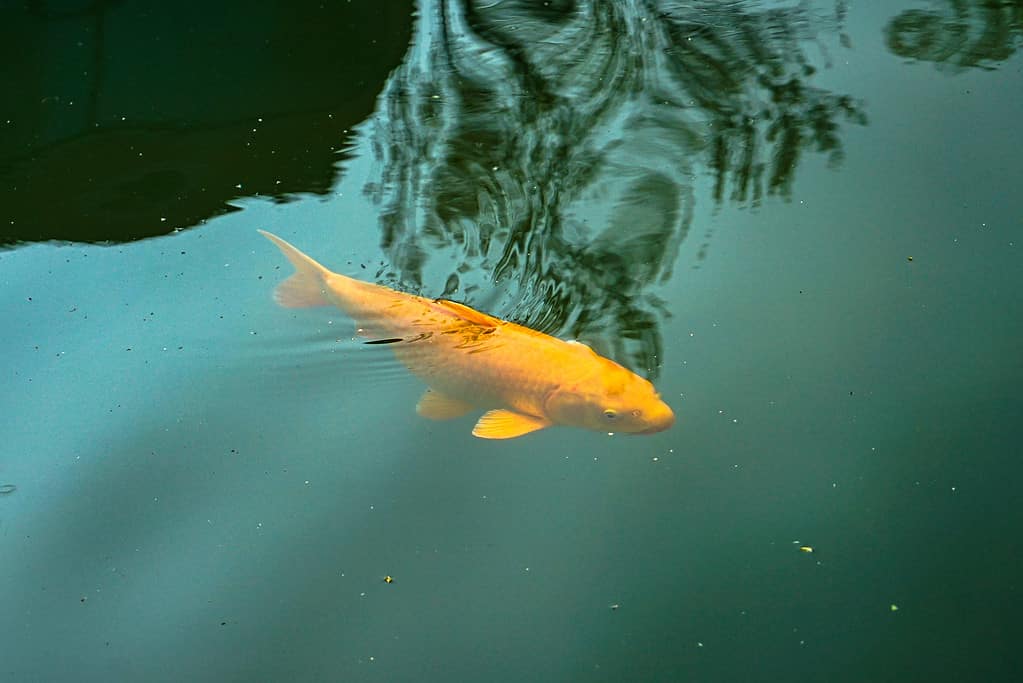
The appearance of the “common” goldfish is instantly recognizable, primarily characterized by the vibrant coppery gold coloration that distinguishes it from other fish species.
©iStock.com/wenpu wang
The look of your “common” goldfish is unmistakable. It is, first and foremost, a brilliant coppery gold color that’s found on no other fish. Those kept as pets usually grow no longer than 3 inches, but they can grow to over 16 inches in size and weigh over 9 pounds.
The body can be torpedo-shaped or egg-shaped, but what most goldfish shares are a pair of pectoral fins, a pair of pelvic fins, one dorsal fin, one anal fin, and one caudal or tail fin.
Their lateral lines, which help them sense pressure, movement, and vibrations in the water bear 27 to 31 scales, but they do not have scales on their heads. They have huge eyes, and their senses of smell and hearing are excellent.
Different breeds can have bubble or telescope eyes, comets, veils, butterfly or fan-shaped tails, heads that look like raspberries, and scales that look like rows of pearls. They can come in the usual gold as well as combinations of black, white, purple, red, brown, or yellow.
Evolution and Origins
Goldfish (Carassius auratus), which were originally domesticated in ancient China, are actually derived from crucian carp, and both are still classified as the same species; crucian carp holds significant agricultural value, with a worldwide aquaculture production of 3.096 million tons in 2018.
During the Song Dynasty (960 AD – 1279 AD) in ancient China, the practice of selectively breeding silver-colored carp began, and during this process, a color mutation emerged, leading to the development of goldfish with yellow-orange scales.
The evolutionary origins of goldfish remain unclear, but past research has suggested that they may have originated from a wild population of crucian carp. It has been theorized that red and yellow variations of goldfish emerged through natural mutations within the wild crucian carp population.
Different Types
Here are the different types of goldfish:
- Oranda
- Ranchu
- Common goldfish
- Fantail
- Comet
- Black Moor
- Goldfish
- Shubunkin
- Ryukin
- Telescope
- Lionhead
- Pearlscale
- Bubble Eye
- Butterfly telescope goldfish
- Carassius auratus langsdorfii
- Panda Telescope
- Wakin
Distribution, Population, and Habitat
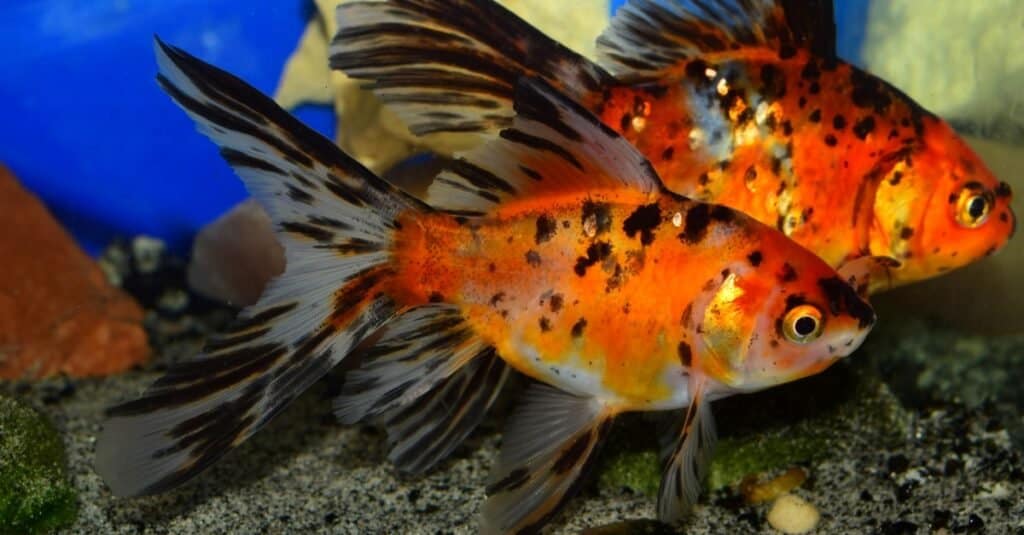
Originally native to China, C. auratus, also known as the goldfish, has achieved worldwide distribution through intentional domestication as a pet and accidental release into various freshwater environments.
©JuanCarlosPalauDiaz/Shutterstock.com
C. auratus is native to China, but it has spread all over the world, either as a pet or an escapee into freshwater bodies. It’s a tough and long-lived fish that prefers cold water and doesn’t mind much if the water is turbid. Besides tanks and bowls, they can be found in pools, ponds, slow rivers, canals, and even drainage ditches.
Predators and Prey
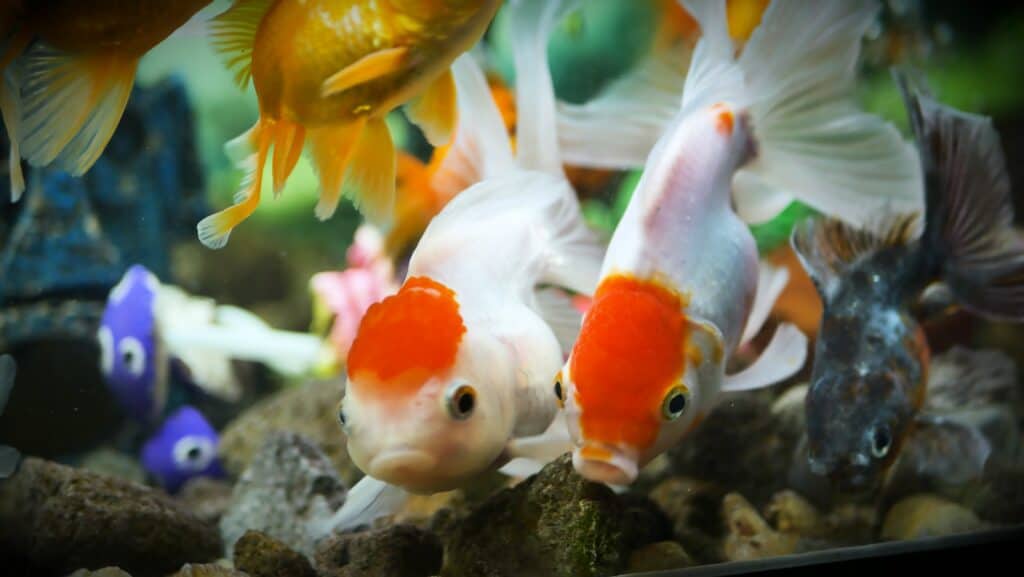
Goldfish are omnivorous creatures, consuming a diet that encompasses both plant material and small animals like mosquito larvae and brine shrimp.
©Last 4ever/Shutterstock.com
Goldfish are omnivores, and their food includes plant material and small animals such as mosquito larvae and brine shrimp. They actually have teeth in their throat, called pharyngeal teeth, which help them grind up their food.
In turn, they are food for any animal that preys on fish. These include turtles, waterbirds such as herons and gulls as well as other, larger fish such as pike.
Reproduction and Lifespan
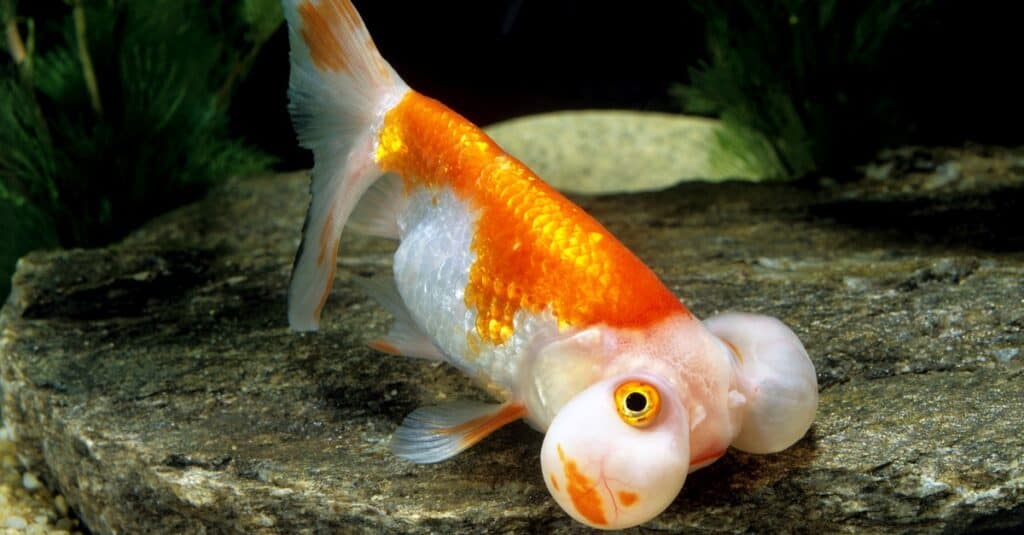
Goldfish can reproduce successfully given appropriate tank maintenance and proper care, with breeding typically occurring in the springtime when in their natural habitat.
©slowmotiongli/Shutterstock.com
Goldfish reproduce if their tank has the right maintenance and if they are given the proper care. In the wild, they start to breed in the spring. Females grow fat with unfertilized eggs, and males chase them around and prod them until they release their eggs.
Then, the male fertilizes them. The eggs are sticky and cling to the leaves of aquatic plants or rocks. They hatch after two to three days.
The baby fish or fry are brown at first, and it may be as long as a year before they take on the glittering gold of their species. Still, they grow very quickly to avoid being eaten. Predators may include adult conspecifics. A pet goldfish can live as long as 25 years, and those in the wild have lived over 40 years.
Fishing and Cooking
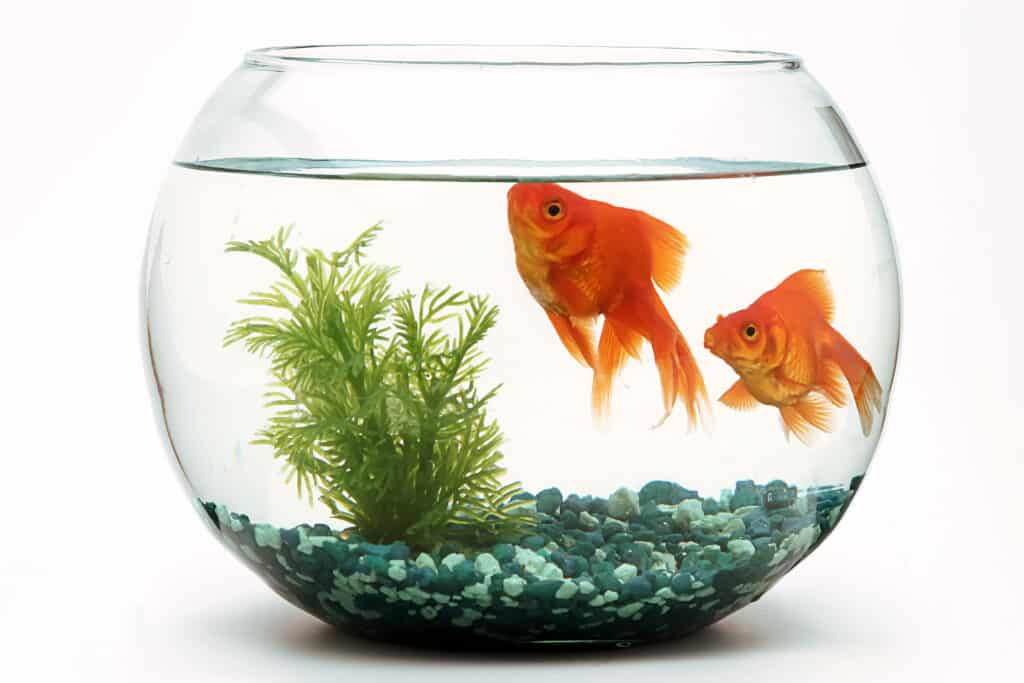
Despite C. auratus belonging to the carp family and being technically edible, it is not commonly utilized in cooking unless an exceptionally large specimen is caught by a fisherman.
©LUIS PADILLA-Fotografia/Shutterstock.com
Though C. auratus is a type of carp and is perfectly edible, it’s not used in cooking unless a fisherman happens to land an unusually large one. In 1939 goldfish swallowing was a fad. Fortunately, it fell out of favor though it is still practiced here and there.
Population
The population ranges at least in the tens of millions, and those released into the wild can breed to the point where they become pests. Lake Ontario alone has at least 50 million goldfish, descendants of pets released into the wild.
View all 170 animals that start with GGoldfish FAQs (Frequently Asked Questions)
Do goldfish recognize their owners?
They do indeed seem to recognize their owners or at least the person who feeds them. This is due to the fish’s high intelligence as well as its keen eyesight.
Is a goldfish a good pet?
C. auratus is a very good pet. It is easy to care for and even easy to train. Common goldfish are not expensive, and the price of one can be as low as 18 cents. The price of a fancy breed can be around $5.00 and the price of a truly rare fish can be $300 or more.
How big do goldfish get?
The biggest C. auratus on record grew to be 18.7 inches long and lived in the Netherlands. A 9-pound fish was found in Oak Grove Lake in South Carolina in 2021.
What is the lifespan of a goldfish?
Most live about 10 years, but they can live 25 years in captivity. Wild goldfish have been known to live for over 40 years.
Why is my goldfish turning white?
A fish that’s turning white might be suffering from white spot diseases. This disease is spread by parasites. White, cottony growths can also be from a fungal infection. These maladies can be avoided if the fish tank receives proper maintenance.
Do goldfish get lonely?
Goldfish don’t get lonely if they’re the only fish in their aquarium. They can be perfectly happy and healthy and live a long life on their own.
Can a goldfish live with a Betta?
C. auratus is mostly a peaceable fish, but bettas are territorial. They may not take kindly to the bright coloration of a goldfish, especially if it has a flowing tail as some breeds do.
Can a goldfish live in a bowl?
A goldfish can live in a bowl, but the maintenance of a bowl is high. It must be cleaned out frequently. Goldfish may be delightful, but they’re filthy.
Can goldfish survive in tap water?
They can survive in tap water if it’s treated with a conditioner before the fish are added. Otherwise, chemicals in untreated tap water can quickly kill them.
How long can a goldfish live in a bag?
They can live between 8 to 12 hours in a bag, but they should be added to their permanent home as soon as possible.
Can goldfish survive without an air pump?
Goldfish in large tanks and ponds can survive without an air pump, but a goldfish in a bowl or small tank needs an air pump to get enough oxygen into the water. The pump doesn’t actually add oxygen but allows for gas exchange.
How long do goldfish live?
They can live between 10 and 41 years.
How big do goldfish get?
Goldfish can grow to as much as 16 inches long, though most are very much smaller than this.
Thank you for reading! Have some feedback for us? Contact the AZ Animals editorial team.
Sources
- ABC News, Available here: https://abcnews.go.com/US/giant-pound-goldfish-found-south-carolina-lake/story?id=74600681
- Betta Care Fish Guide, Available here: https://www.bettacarefishguide.com/betta-tank-mates-list-of-fish-that-can-live-with-bettas/
- Pet Keen, Available here: https://petkeen.com/the-price-of-a-pet-goldfish/
- Fishbase, Available here: https://www.fishbase.se/summary/271
- Neeness, Available here: https://neeness.com/how-fast-can-goldfish-swim/
- Wikipedia, Available here: https://en.wikipedia.org/wiki/Goldfish
- USGS, Available here: https://nas.er.usgs.gov/queries/factsheet.aspx?SpeciesID=508
- CTV News, Available here: https://www.ctvnews.ca/sci-tech/up-to-50-million-goldfish-in-lake-ontario-hurting-ecosystem-1.4095198

















